Fast Track to Sourdough
Sourdough English Muffin Bread
If you just finished our "Introduction to Baking" recipes, you may be having a deja vu moment. 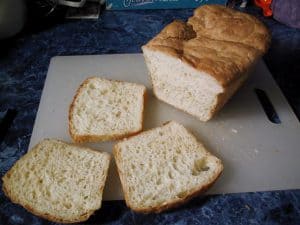 However, this is one of those breads we make both as a yeasted bread and as a sourdough bread. This one is part of our :Fast Track to Sourdough" series of articles.
However, this is one of those breads we make both as a yeasted bread and as a sourdough bread. This one is part of our :Fast Track to Sourdough" series of articles.
Which one is better? We think the sourdough version is better, but both are very good. You can make up your own mind. In any case, this is one of our favorite breads. It's like a loaf of English Muffins, only better than what you get at the store. Just slice and enjoy! The recipe will make 2 1.5 pound loaves, or 3 1 pound loaves. Finally, please be aware that the cups and gram measurements are approximations of one another. Most people who measure in grams do not want to weigh out 1,234 grams. 1,230 is close enough. Nor do people using cups want strange cup measurements like 3/16 cup. So, please don't think that, for example, 90 grams of flour is 1/2 cup. The most accurate numbers here are the bakers percentages.
Ingredients:
| Volumetric Measurement (Cups) | Ingredient | Grams | Baker's Percentage |
|---|---|---|---|
| 1 2/3 Cups | Water | 390 Grams | 71% |
| 2 cups | Active Sourdough Starter | 540 Grams | 98% |
| 4 1/2 Cups | All-purpose Flour | 550 Grams | 100% |
| 5 1/3 tsp | Sugar | 32 Grams | 5.88% |
| 4 tsp | salt | 23 Grams | 4.12% (1) |
| 1/2 Cup | Instant Milk (2) | 54 Grams | 9.8% |
| 1/4 tsp | Baking Soda (3) | .5 grams | .6% |
Notes:
- The amount of salt is rather high. In his younger years James Beard loved salt. If I revisit this recipe, I'll probably cut the salt down to 2 tsp or 12 grams, or about 2%. While salt ads savor, it also can be a problem for salt sensitive people. In the UK and EU, bread is limited to about 1.5% salt.
- Instant milk. I love it! I hate it! We didn't use much fresh milk at the bakery, so instant milk kept better. Still, fresh milk tastes better. You can replace the water with whole milk and omit the powdered milk.
- Dissolve the baking soda in 2 TBSP (30 grams) of water and hold it back until called for.
Method: Put the flour, milk powder, salt, and sugar into a mixing bowl. Add the water and sourdough starter. Stir well.
Mixing the ingredients The idea is to stir this until it is smooth, and to develop gluten in the dough through stirring. Gluten is a stringy protein that gives bread its structure. It is a major protein in wheat flour. The dough comes together as you stir it. The stirring process helps align the gluten. As you stir, you'll see strands begin to form. This stirring technique is used in many Italian breads, because Italian flours have a lot less protein than American flours. Stirring helps combine ingredients and, while this bread is NOT kneaded, it gets dough ready for kneading. (Or, you stir all doughs, you only knead some. Not this one.)
The Rise Once the dough is well stirred, which should only take a few minutes, it's time to cover it and let rise until doubled in size. This should take about 45 minutes to an hour to an hour and a half, depending on your starter and the temperature in your kitchen. During this time, the rise will help further develop the gluten.
Adding the soda Once the dough has doubled in size, it's time to add add the baking soda dissolved in a tablespoon or so of water. Stir the dough to deflate it and mix in the baking soda and water. As you stir the dough down you'll again see the gluten strands. They'll stick to the side of the bowl and your spoon. You want the dough to be small and smooth again.
 |
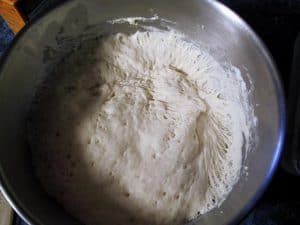 |
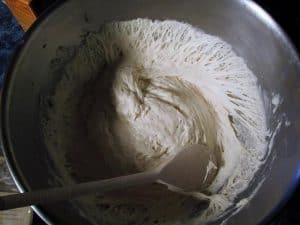 |
 |
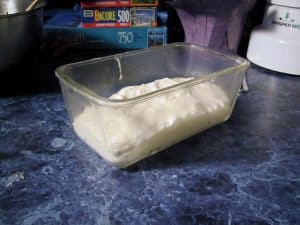 |
 |
Loafin' Once the dough is smooth, it's time to pour it into greased bread pans. Pour equal amounts of the dough into two or three oiled bread pans. Once the dough is in the pans, smooth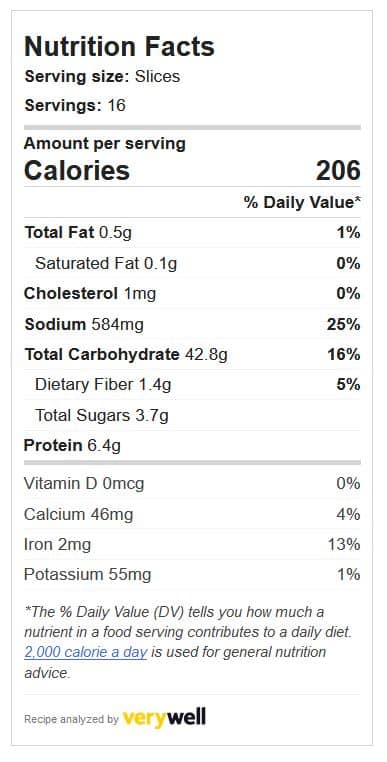 the surface of the dough, either with a spatula or floured hands. The dough is quite sticky. As soon as you get the dough out of the mixing and rising bowl, fill the bowl with water - it will make cleanup a lot easier! Once again, cover the bread pan and allow the bread to rise in a warm place until it's doubled in size, which should take about an hour or so.
the surface of the dough, either with a spatula or floured hands. The dough is quite sticky. As soon as you get the dough out of the mixing and rising bowl, fill the bowl with water - it will make cleanup a lot easier! Once again, cover the bread pan and allow the bread to rise in a warm place until it's doubled in size, which should take about an hour or so.
Preparing for the bake About 40 minutes into this rise, start pre-heating the oven. That is, turn it on and set the oven temperature to 375F. Once the rise is complete, and the oven is at the correct temperature, put the loaves of bread into the oven to bake.
The end game Check the loaf about 25 minutes later. You want a nicely browned loaf. The baked loaf should have begun to pull away from the edges of the bread pan. This bread is intended to be toasted, so you may not want it to brown as much as most loaves. When you think the loaf is done, remove it from the oven and let it cool on a rack and in the pan for 5 minutes or so. Then gently remove the loaves from their pans and let them cool completely on the rack. This is a very fragile bread, so don't get it out of the baking pan too soon and be careful or you could tear it up!
Enjoy! Once it's cool, slice it into 1/2-inch slices, toast, and enjoy! You may also treat the slices like an English Muffin and fry them in butter.... just don't tell your doctor I suggested this.
Now that you're done with this bread, it would be a great time to move on to the Black Canyon Sourdough Bread.


Hi would you mind clarifying for me as to whether / when this bread gets kneaded? You describe stirring the ingredients to mix as preparing the dough for kneading but then don’t actually seem to mention that taking place.
Thanks!
Hi Ian. I clarified the article. This bread is NOT kneaded. It is a batter bread. Stir it and let it rise!
Stirring gets a dough ready to knead, if it needs to be kneaded.
-Mike
Got it! Thanks Mike
I make yeast English muffin bread on a regular basis, and always have active starter. My question is, could I use my hand mixer to mix for several minutes before adding all the flour, as I do with yeast recipe? My recipe only has one rise. And can I still line greased pans with cornmeal before baking and some on top prior to putting in the oven?
May have to try this!
Many people seem to think that when they use sourdough they have slipped into some alternate universe. Actually, there are few differences between yeast baking and sourdough baking. Sourdough does take longer, and you have to maintain your starter, but other than that what works for yeast baking almost always works for sourdough baking.
So, to answer your question, I don’t see any reason you can’t do that.
Best wishes,
-Mike
This looks delicious! I’ll be making this week for sure. I saw you talked about protein when discussing the Italian stirring method but I can’t seem to find what you suggest for this loaf. Do you prefer to use a high-protein flour or AP? Also, can you share loaf pan sizes for when you divide into two and three loafs? Thank you!!
Hi Kathleen,
Thanks for pointing that out. I’ve updated the recipe to read “All-purpose Flour” instead of just “Flour”.
As I write this, we are in the throes of Covid-19 Shelter In Place and many grocery stores have rather bare shelves. If you don’t have All-Purpose flour, Bread Flour will work also. I would not use self-rising flour or cake flour. If you use about 2 cups of water, you could use whole wheat flour, but it really wouldn’t be the same bread. However, when you can’t get the ingredients you want, you have to use the ingredients you have.
-Mike
Thanks, Mike! I appreciate it. Happy baking and stay safe!
Thank you for your precise instructions and details. My family adored this! I used almond milk. I reduced the salt to half as suggested and my family felt it could use more. So, I guess we’ll to go with James Beard!
Hi Julie,
Thanks for letting us know the almond milk worked out.
On the salt front, if it works for you, it’s right.
Best wishes,
Mike
I live in the SF bay area, and have made this several times now. It’s delicious, but the initial rise takes more like 12-15 hours for the dough to double in size (as opposed to the 45 minutes to 1.5 hours stated), and the 2nd rise also takes a lot longer.
Hi Michelle,
That is very odd! The time frames are what I recall. I’ll give the recipe another try and see what happens.
Some reasons yours could take longer –
1. Temperature – San Francisco is known for being cold. I get the dough temperature into the 70 to 80F range, and keep the proofing area in the same temperature range.
2. Tired Starter – all starters are different, but I suggest you use a fresh active starter for this, not discard.
3. Immature starter – I don’t suggest using any starter until it is at least a week old and can reliably double (or better) itself between feedings.
Hope this helps,
Mike
Please tell what ‘cake’ flour is. I am very new to sourdough baking – made my first brick tonight 🙁
Hi Cynthia,
The cake flour is almost certainly A cause of your creating a brick. Cake flour is a highly refined, low protein, bleached flour found mostly in the USA. Higher protein levels tend to make a cake tough, however higher protein levels are needed to make a bread rise. We tried to make bread in our Flour Test with cake flour. It didn’t go well and we don’t recommend using cake flour to make bread.
All-purpose flour works quite well, as does bread flour.
Good luck,
-Mike
If I want to use regular milk instead of instant, you say to replace the water with the milk. How does that affect the addition of the baking soda? In the recipe water gets “used” twice – at the beginning with the starter and then with the baking soda. How much to use when? Help! Thanks
Hi Martha,
I added a few words to clarify the recipe. The baking soda is dissolved in a very small amount of water, like a tablespoon. You could use milk if you’d rather, but I don’t think it would make any real difference.
Let me know how it turns out,
Mike
One reason I use sourdough is the slow rise makes the bread easier to digest. Is it possible to do the second rise in the fridge overnight? Have you ever done such a thing?
Hi Tara,
The cost of this bread, in terms of time and materials, is so low you could have gotten your answer a lot faster by just trying it.
Also, sourdough had a reputation for being more digestible than other breads long before the current obsession with long overnight rises took hold. Just that a bread is risen with sourdough makes a big difference.
All that said, a lot of the rise on this bread is from the chemical action between the baking soda and the acidity in the sourdough starter. I haven;t given this bread a long rise, and I’m not at all sure how well it would survive a long rise. If you don’t add the baking soda, you’d just have white bread. While that’s not bad, it wasn’t the goal of this recipe.
My suggestion here would be to make two loaves. Make one as give in the recipe, and let the other one rise slowly overnight in the fridge. Once you bake, you’ll know instead of relying on my baseless suppositions. That said, if you do the experiment, please let me know how it turns out.
-Mike
would be helpful to know what size loaf pans are being used, or at the very least, how full should each loaf pan be prior to second rise. In the photos there seems to be very little dough in the pan initially maybe just less than a third full) and it seems to rise substantially (just past the top rim) before baking. Am seeing this correctly? Thx.
Hi Thomas,
We no longer have the exact pan we used in the pictures (and I’d love to know what happened to it!). We have similar pans that are 22x11x8cm, or 8.66 x 4.33 x 3.14 inches. It isn’t clear why Pyrex labeled this pan in centimeters and sold it in the USA – there were no inch measurements on the pan!
We filled the pan between 1/3 and 1/2 full. How much you fill it will, in practice, depend on how much your starter rises. Which, in turn, depends on how mature your starter is and how you care for it. If the batter doesn’t fill the pan, use more next time. If it overflows, use less next time. Sadly, I can’t share a hard and fast rule here.
Best wishes,
Mike
Ok, thanks. Yeah, I’m using 8×4 and there seems to be about a little more than 2 pans worth of dough. It was a bit wet and started to “muffin top” over the edges a bit and didn’t really spring up that much from there. As with many new recipes, try try again!